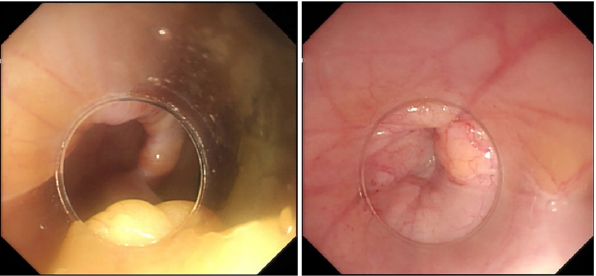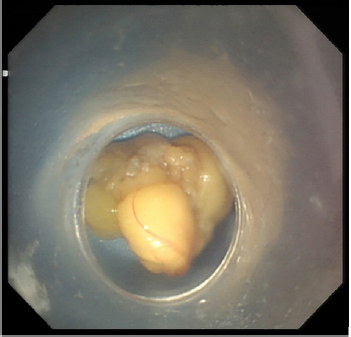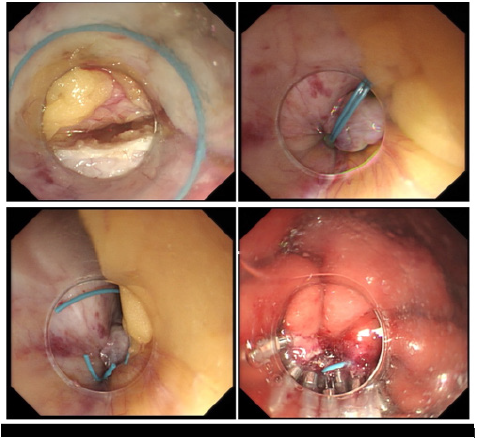Abstract
Abbreviations: NOTES: Natural Orifice Transluminal Endoscopic Surgery
Introduction
Inguinal hernia has been repaired with verity of approaches with growing evidence comparing open, laparoscopic transabdominal peritoneal and total extra peritoneal approaches [1]. Open tension free, mesh repair has been long the gold standard for inguinal herniorrhaphy [2]. This technique entails a sizeable skin incision and dissection, leading to poor cosmetics results, postoperative pain and delayed return activities to daily life. Because of only mild improvement in the post-operative pain and increased cost, the laparoscopic techniques for inguinal herniorrhaphy have also not been widely accepted. The open technique remains the most common approach [3-6]. Here we report, Inguinal herniorrhaphy using pure natural orifice transluminal endoscopic surgery (NOTES).
Case Report and Description of Technology
A 51-year-old woman presented because of a bulge in the left lower abdomen. Examination showed an egg-size bulge (inguinal hernia) when standing. The patient declined open or laparoscopic repair. Following explanation of the standard of care alternatives and details of novel procedure the patient consented for pure natural orifice transluminal endoscopic surgery (NOTES) hernioplasty. With the patient in the supine position an endoscope was inserted, and the stomach was cleansed with normal saline. An incision was then created on the anterior gastric wall using Hook/ IT knives. An endoscope with a transparent cap was introduced through the peritoneal cavity into the groin area. The hernia sacs identified (Figure 1A). A normal saline/epinephrine solution was injected into the subserosa layer of the hernia which was dissected using Hook/IT knives and resected with a snare (Figure 1B). The specimen was removed through the gastric incision with snare assistance (Figure 1C). A foreign body forceps was used to grasp the sides the incision which were then pulled into the transparent cap. Nylon loops were used to close the incision site and endoscopic scissors to cut the tails of the nylon loops. Finally, the gastric stoma was closed using endoloops and endoclips (Figure 1D). No significant bleeding or other complications occurred either during or after the procedure. The patient was discharged after 3 days. No recurrence or other adverse events have occurred during 40 months of follow-up.
Take Home Message
We successfully performed pure natural orifice transluminal endoscopic surgery hernioplasty. NOTES eliminate skin incision and may potentially reduce or abolish pain and decrease time to return to the activity. This study shows that NOTES-inguinal herniorrhaphy is feasible and can be performed safely with standard endoscopic instrument. The strength of this case report is in its originality and problem solving. This is an only single case, further studies including animal survival studies and ultimately human trails are required before announcing it as a standard of care for inguinal hernorrhaphy.
Acknowledgment
We express our gratitude to Professor David Y. Graham, Professor of Medicine, Molecular virology and Microbiology, Baylor college of Medicine for his encouragement and assistance in revising the manuscript.
Disclosures
All authors disclosed no financial relationships related to this publication.
Patient Consent
The informed consent was obtained from the patient for the publication of their information and imaging.
Author Contributions
a. Study concept and design: Bing-Rong Liu
b. Acquisition of data: Saif Ullah, Chao Pan
c. Manuscript writing: Saif Ullah
d. Administrative, technical or material support: Li-Xia Zhao, Yangyang Zhou
e. Critical revision of manuscript: Bing-Rong Liu.
References
- Stavert B, Chan DL, Ozmen J, Loi K (2019) Laparoscopic totally extra-peritoneal groin hernia repair with self-gripping polyester mesh: a series of 780 repairs. ANZ J Surg 89(10):1261-1264.
- Zhu X, Cao H, Ma Y, Yuan A, Wu X, et al. (2014) Totally extraperitoneal laparoscopic hernioplasty versus open extraperitoneal approach for inguinal hernia repair: A meta-analysis of outcomes of our current knowledge. Surgeon 12(2): 94-105.
- Neumayer L, Giobbie Herder A, Jonasson O, Fitzgibbons R Jr, Dunlop D, et al. (2004) Open mesh versus laparoscopic mesh repair of inguinal hernia. N Engl J Med 350(18): 1819-1827.
- Pisanu A, Podda M, Saba A, Porceddu G, Uccheddu A (2015) Meta-analysis and review of prospective randomized trials comparing laparoscopic and Lichtenstein techniques in recurrent inguinal hernia repair. Hernia 19(3): 355-366.
- He K, Chen H, Ding R, Hua R, Yao Q, et al. (2011) Single incision laparoscopic totally extraperitoneal inguinal hernia repair. Hernia 15(4): 451-453.

 Case Report
Case Report



